About a year ago, I wrote a post about some Browning 1919 feeding devices that were patented but never went into production. Well, reader Alex found photos of one of them in the Springfield Armory archives. Thanks, Alex!
It’s a belt box designed to be clipped onto the top cover of a slightly modified Browning 1919 to provide a compact and un-cluttered ammunition feed. The photos are dated February 15th, 1927 – and it was tested with the intention of using on aircraft guns.
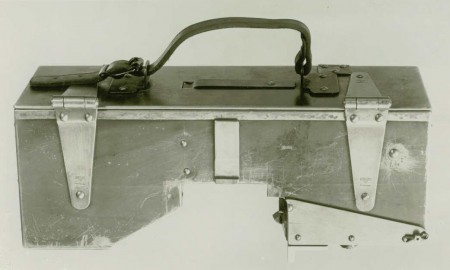
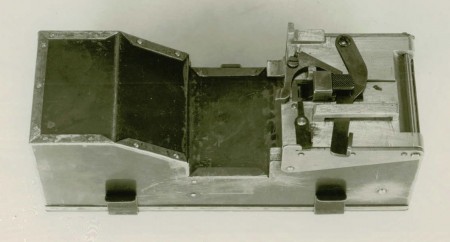
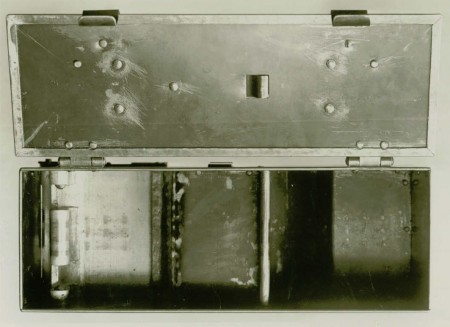
I initially called this a saddle magazine, but it appears to actually be a belt box (like the MG42 50-round assault drum). It serves simply to hold the belted ammo in place and feed it smoothly to the gun, where a true saddle magazine (like the German double drum for the MG15 and MG34) includes a complete feed mechanism and is loaded with loose cartridges.
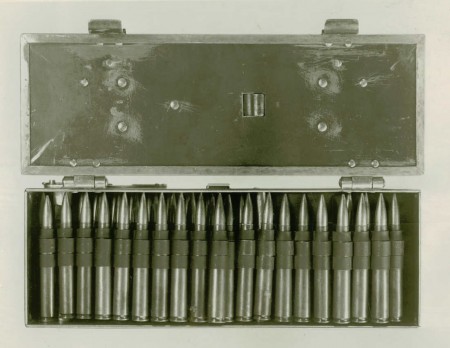
Note that the patent for this was applied for in January of 1926, but not granted until April 1931 – 4 years after these photos were taken. You can find the patent in full here:
US Patent 1,800,595 (J. M. Browning, “Magazine Feed Mechanism for Machine Guns”, April 14, 1931)
This belt box was tested on a Browning T2 machine gun – an experimental variant of the M1919 which also included provisions for being able to feed from either the right or left – a feature much desired for aircraft use (and a feature not necessarily important if belt boxes like this one were used). The Springfield Arsenal Museum also has three photos of the T2 used with the experimental box – two with it in place and one without:
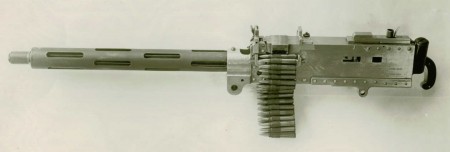

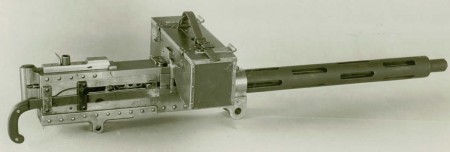

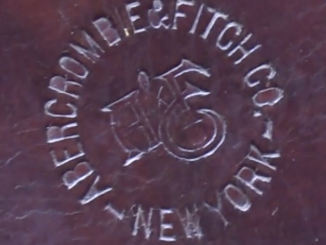
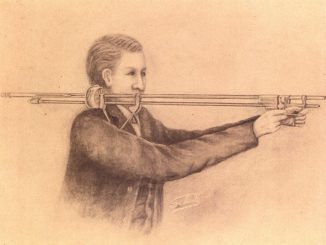
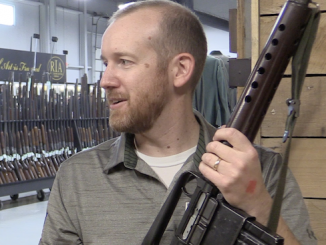
I can see that this makes a compact parcel that could be mounted in the nose of a fighter plane. Seeing as the bolt engages a charging handle which looks like a saw grip, this T2 is definitely mounted in front of a pilot. The only thing left to do is install the synchronization gearing with the engine so you won’t shoot off the propeller during a dogfight!
When did the transition from cloth belts to metallic links occur? I was under the (apparently mistaken) impression that cloth belts were still in use at this time.
Metallic links had been in use with aircraft guns since WWI.
Maybe I’m missing something, but it would seem that the main advantage would be quick turn around time by the ground crew when a plane returned to refuel.
Good point. Also, like the pan magazine of the Lewis gun, this setup would allow quick reloading in the air, remembering that fighter guns of the day were mounted on or in the decking in front of the cockpit. It would be even more convenient for flexible guns on a Scarff ring, as on the bombers of the time.
The only drawback would be that even with twin guns mounted ahead of the pilot (think Thomas-Morse Scout), the height of the box(es) would require a higher front and rear ring/post sight setup to allow the pilot to see the sights between the guns. Probably a higher pilot seating position, too. This may be why the project was abandoned.
Now, a box like this mounted to right or left of the gun, with its long axis vertical, and feeding in like a ground gun’s boxed belt-feed, wouldn’t have that problem. Partly recessed into the fuselage side, it would generate less drag, as well. Although fighters of the era certainly had enough drag-producing bits hanging out all over to begin with, that two more might not have made that much difference, aerodynamically speaking.
cheers
eon
The fabric belts, were used in the infantery version, the aircraft models, used the theloose links
I think the use of a fixed-type gun was for test purposes. It seems more likely to me that the gun would have been used in a flexible installation had it been accepted.
Curious as to what the two ‘witness holes’ are for on the left side plate? Also interesting is the lack of a booster at the muzzle. Yeah, I now – a bit of topic drift. lol
Those are for the synchronizer.
+1 for Eli. A synchronizer was developed for the predecessor to this model, the 1918 Aircraft gun, by Carl Gustaf Swebilius, and those windows were intended for that device. The model shown above, the T2 seems to be a further development of the 1919 Aircraft gun, adopted in the 1920s and produced at Colt’s and Springfield. The outward appearance is identical to the 1919 model, quite different than the 1918 model which was the WWI, 1917 WC style receiver in an air cooled variation, with lighter reciprocating parts for a far faster cyclic rate. The T2 developments turned towards the scaled down ANM2/MG40 series. Good information on all this in Dolf Goldsmith’s The Browning Machine Gun Vol I. Not sure, but I don’t think these ammo box developments ever were produced for the full size Aircraft Brownings.